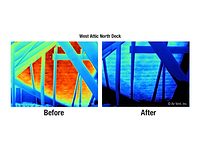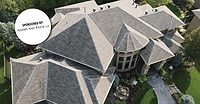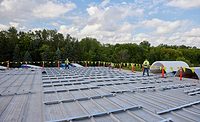A new analysis of the roofing industry from the Freedonia Group shows the demand for residential roofing will grow along with the demand for metal and solar roofing in the next three years.
The research company released “Residential Roofing,” an analysis of the demand for roofing in the U.S. by product, slope and geographic region. According to the report, metal roofing, solar roofing and roofing tile will see the largest sales through 2025.
Metal is on the rise, as is roofing tiles, for their superior resistance to severe weather events, long lifespan and ability to serve as cool roofing. The growing popularity of these products is also linked to the price of petroleum and petroleum-related products sharply increasing, which will drive the price of asphalt shingles and bituminous low-slope membranes.
“While these items are more costly, many consumers do not mind paying for them due to their longer product lifespans (reducing long-term replacement costs) and ability to enhance the ‘curb appeal’ of a structure,” the research company said in a release.
These findings coincide with RC’s 2022 State of the Industry Report, with contractors reporting the use of metal roofing (78%) slightly exceeding steep-slope asphalt shingles (77%) for the first time.
Despite the rise in metal and tile products, however, asphalt shingles are likely to account for the largest share of residential roofing demand due to lower costs and ease of installation. The State of the Industry Report showed metal roofing only accounted for 18% of overall sales, compared to 30% for shingles.
On the solar side, the report indicates solar roofing will expand “at a robust rate” due to California’s adoption of building codes requiring solar in newly built and significantly renovated structures. That being said, proposed changes to rules affecting net energy metering in California may affect this projection.
Smaller volume products are anticipated to register rapid gains in terms of value, especially bituminous roofing in the South due to its moisture resistance.
Residential Market Growth
The analysis forecasts roofing demand in value will rise at an annual average pace of 8.2% through 2025. Price increases and a shift for higher value roofing products, like the ones previously listed, will be a cause for this growth.
Residential roofing market growth will remain minimal. The large amount of storm-related reroofing that took place in 2020 is expected to slow growth, as these roofs will not likely require additional work in the short term.
A smaller new housing segment is expected to drive growth. The report predicts new roofing, particularly among construction of single-family homes, will account for twice as many gains as reroofing. This is, in part, due to the COVID-19 pandemic, where people desired to escape urban areas severely affected by COVID and built homes in suburban areas.
This isn’t to say reroofing won’t happen. The reroofing market will account for about 80% of demand, though that growth will be limited by the significant amount of older and worn roofs replaced in 2020 due to the pandemic spurring an increase in home improvement projects.







